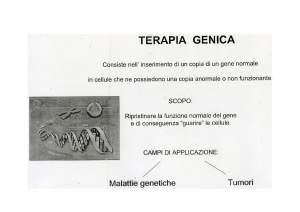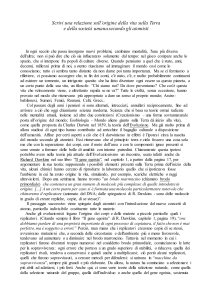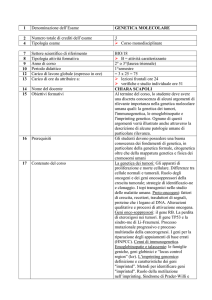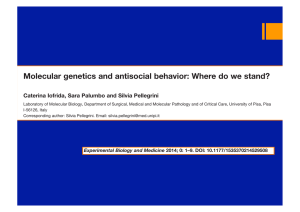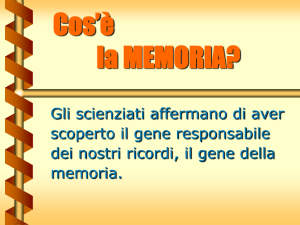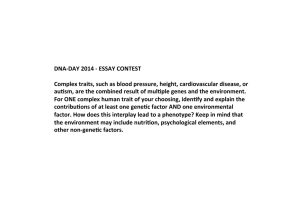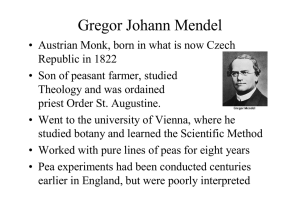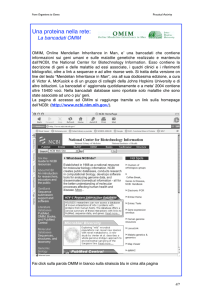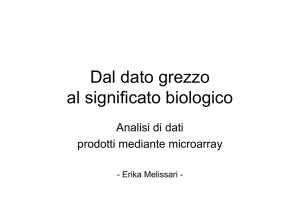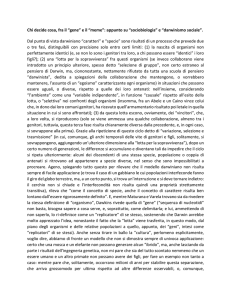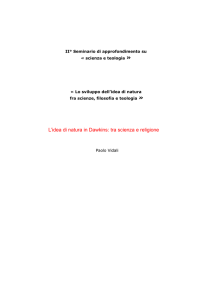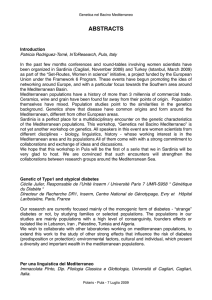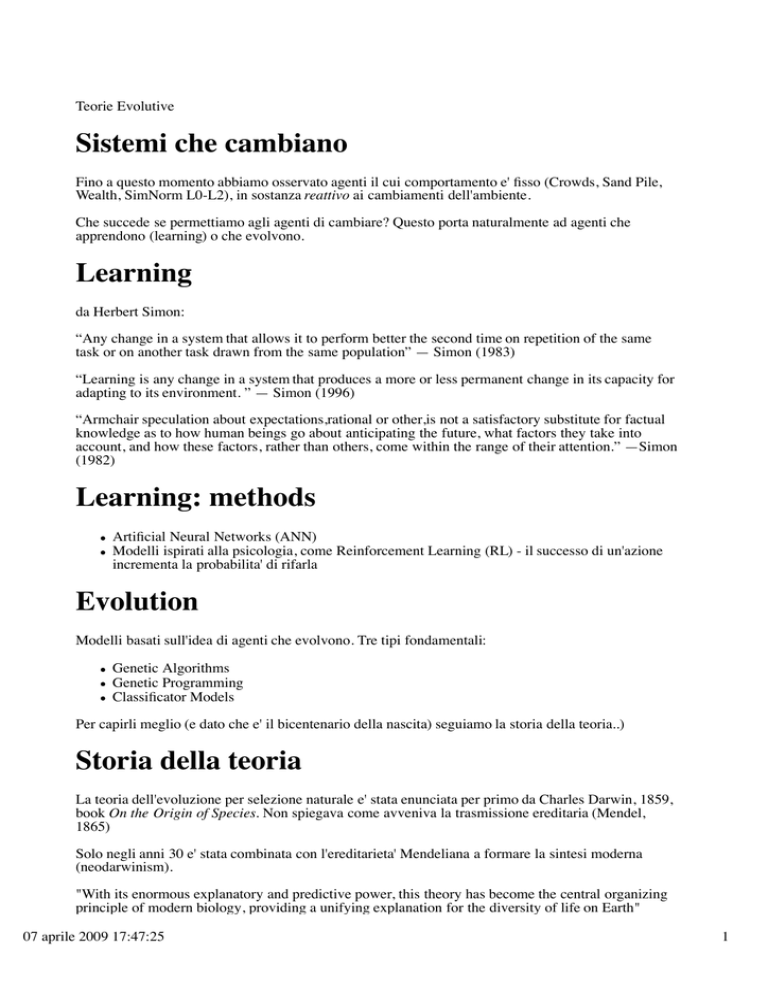
Teorie Evolutive
Sistemi che cambiano
Fino a questo momento abbiamo osservato agenti il cui comportamento e' fisso (Crowds, Sand Pile,
Wealth, SimNorm L0-L2), in sostanza reattivo ai cambiamenti dell'ambiente.
Che succede se permettiamo agli agenti di cambiare? Questo porta naturalmente ad agenti che
apprendono (learning) o che evolvono.
Learning
da Herbert Simon:
“Any change in a system that allows it to perform better the second time on repetition of the same
task or on another task drawn from the same population” — Simon (1983)
“Learning is any change in a system that produces a more or less permanent change in its capacity for
adapting to its environment. ” — Simon (1996)
“Armchair speculation about expectations,rational or other,is not a satisfactory substitute for factual
knowledge as to how human beings go about anticipating the future, what factors they take into
account, and how these factors, rather than others, come within the range of their attention.” —Simon
(1982)
Learning: methods
Artificial Neural Networks (ANN)
Modelli ispirati alla psicologia, come Reinforcement Learning (RL) - il successo di un'azione
incrementa la probabilita' di rifarla
Evolution
Modelli basati sull'idea di agenti che evolvono. Tre tipi fondamentali:
Genetic Algorithms
Genetic Programming
Classificator Models
Per capirli meglio (e dato che e' il bicentenario della nascita) seguiamo la storia della teoria..)
Storia della teoria
La teoria dell'evoluzione per selezione naturale e' stata enunciata per primo da Charles Darwin, 1859,
book On the Origin of Species. Non spiegava come avveniva la trasmissione ereditaria (Mendel,
1865)
Solo negli anni 30 e' stata combinata con l'ereditarieta' Mendeliana a formare la sintesi moderna
(neodarwinism).
"With its enormous explanatory and predictive power, this theory has become the central organizing
principle of modern biology, providing a unifying explanation for the diversity of life on Earth"
07 aprile 2009 17:47:25
1
"With its enormous explanatory and predictive power, this theory has become the central organizing
principle of modern biology, providing a unifying explanation for the diversity of life on Earth"
La teoria continua a cambiare e a migliorare
Darwin, 1865
the initial assumptions for the validity of Darwin’s theory of the origin of the species by means of
natural selection:
1. On an average, an organism has more than one offspring during its lifetime (or apair of parents
more than two offspring) – thus the population should grow.
2. At the same time, the number of individuals remains constant in the long term – the excess
offspring die without reproducing.
3. Individuals of aparticular species differ from one another (i.e. there is variability within the
species).
4. The probability of surviving to adulthood and reproducing depend on the traits of each
individual.
5. The traits of individuals are inherited – on an average, descendants are similar to their parents
more than to the other members of the population.
Come e' iniziato?
Sopravvivenza di cio' che e' stabile
atomi
molecole
cristalli
emoglobina (proteina del sangue)
574 aminoacidi (ciascuno formato da poche dozzine di atomi)
esattamente identica nella forma
uno di noi ne ha 6 000 000 000 000 000 000 000
non c'e' un motivo - funziona semplicemente cosi'
ma di certo non si trova "per caso".. o no? Quale caso?
La vecchia storia del brodo
sostanze (carbonio, ossigeno) e scariche elettriche formano per caso molecole organiche
in assenza di batteri, ovviamente
una di queste potrebbe essere un replicatore
si appiccica addosso queste molecole fino a formare una copia di se' (positivo-negativo,
probabilmente)
errori di copiatura (come negli antichi manoscritti)
un replicatore continua a generare copie di se stesso finche' c'e' materiale
osservando li brodo, non sembra piu' tanto casuale..
Competizione tra replicatori
le sostanze a disposizione non sono infinite
gli errori di copiatura generano replicatori diversi
Caratteristiche fondamentali:
longevita' (piu' tempo per far copie)
07 aprile 2009 17:47:25
2
fecondita' (velocita' di riproduzione)
accuratezza (pochi errori di copiatura)
Per un replicatore, queste sono tutte caratteristiche positive (tautologia); mentre ai fini evolutivi, la
mancanza di accuratezza permette di esplorare soluzioni nuove (ma quasi sempre fatali)
Accuratezza vs. Esplorazione
un replicatore esatto (clone) riempie il mondo di sue copie, MA..
.. non esplora soluzioni nuove
Utili trucchi
rompere gli altri replicatori e usarli come materiale da costruzione
proteggersi con barriere proteiche (cellule?)
allearsi con altri replicatori in modo complesso (geni e cromosomi, riproduzione sessuata e
alleli)
costruire macchine da sopravvivenza (noi?)
la maggior parte delle cellule di un organismo sono molto altruiste: i loro replicatori
terminano li'
A problem with the initial idea: averaging
It is an essential condition for the functioning of this evolution that variability must be formed in the
population with at least the same speed as it disappears. And agreat many of Darwin’s opponents
thought this is not true. Most species that we encounter in nature reproduce sexually. Each individual
of asexually reproducing species has two parents and the properties that it inherits from them are
mostly more or less an average of the properties of these two parents. If an individual has atall father
and short mother, his size will be somewhere between them, closer to the average. If he has alarge
mother and an average-sized father, his size will again be somewhere between them, i.e. aboveaverage, but not to the same degree as his mother’s size. This averaging of traits has, however, the
disadvantage that it rapidly removes variability from the population. In fact, it can be derived
mathematically that half the variability present disappears in each generation.
Adaptation
"Adaptive hypotheses, however wild and speculative, must not be vaguely Panglossian but precisely
limited to specified alleles (or other replicators) which vary and which exert a causal influence on
variation in the phenotype of interest. " (Dawkins 2004)
Selezione Naturale
Quasi una tautologia: chi produce piu' discendenza occupa il mondo
Alcune definizioni curiosamente invertono la causalita':
"Fitter individuals have more offspring to pass their genes to; less fit indivuduals have less" (Marks
2007)
Ma e' la discendenza (e la sua riproduzione!) che decide la fitness in natura.
I programmi al computer invece usano l'approccio contrario - prima il calcolo della fitness, poi le
chance di riproduzione.
07 aprile 2009 17:47:25
3
Competion for Resources
In nature, individual organisms compete with each other for resources, such as food, water and
shelter.
Individuals of the same species also compete for mates.
Those individuals that are the most successful in surviving and finding mates (the ‘fittest’ individuals)
will be the most likely to produce offspring, while relatively unsuccessful individuals will have fewer
or no offspring.
Each individual has a set of ‘genes’ (composed of DNA in the cell nucleus) which determine the form
of its body and its abilities. Sexual reproduction involves combining the genes of two parents from
the same species and passing the combination to the offspring.
Thus the genes of the fittest individuals are spread to the next generation.
Teorie Evolutive
L'evoluzione biologica e' il cambiamento nei tratti ereditati di una popolazione di generazione in
generazione.
I tratti sono codificati da geni, copiati e trasmessi durante la riproduzione. Le mutazioni dei geni
(genotipo) possono produrre tratti nuovi o alterati, che risultano in differenze ereditabili tra gli
organismi (fenotipo).
Lo stesso genotipo puo' produrre diversi fenotipi (morfogenesi)
La pressione evolutiva porta cambiamenti nelle popolazioni semplicemente per "genetic drift" o
attraverso la selezione naturale (miglior comportamento riproduttivo dei fenotipi)
Termini
Chromosomes in biology are chains of DNA found in the cell nucleus, composed of sequences
of
genes, each of which occupies a fixed place on the chromosome (the gene’s locus) and provides
the code for one or more related functions.
The complete set of chromosomes is an organism’s genome.
The overall genetic composition of an individual is its genotype
the characteristics of an individual expressed by its genome are known as its phenotype.
ontogenesis is the expression of the genotype in a phenotype
alleles are different genes that compete for the same position in the genoma.
For example, I have a Y chromosome consisting of several genes as part of my genome which causes
my sex to be male, an aspect of my phenotype.
Collaborazione o competizione?
Se il materiale a disposizione e' lo stesso per tutti non ci si aspetta collaborazione. Ma questa puo'
emergere da un'aspettativa di futuro condiviso. Permetto agli altri geni di replicarsi perche' conto
portino anche me.
Un buon trucco per essere sicuri che il gruppo rimanga unito e' quello di mettere un collo di bottiglia
nel processo (bottleneck). Vale per gli animali come per i nidi delle termiti.
07 aprile 2009 17:47:25
4
bottleneck
"What draws them, in a Darwinian sense, to cooperate is again ‘bottlenecking’: a shared statistical
expectation of the future. This shared expectation follows directly from the method of reproduction,
according to which all of an organism’s ‘own’ nuclear genes, and its cytoplasmic genes for good
measure, pass to the next generation in a shared propagule. To the extent that this is true of parasite
genes (for example bacteria that travel inside the host’s egg), to that very same extent aggressive
parasitism will give way in evolutionary time to amicable and cooperative symbiosis."
"Both ‘want’ a host phenotype that survives and reproduces. But to the extent that parasite genes pass
to their own next generation via some sideways route which is not shared with those of the host
genes, to that same extent the parasite will tend to be vicious and dangerous. In such cases, the
optimum phenotype from the parasite genes’ point of view may well be dead – perhaps having burst
in a cloud parasite spores. All our ‘own’ genes are mutually parasitic, but they are amicably
cooperative parasites because their shared route to the future in every generation leads them to ‘see
eye to eye’ on the optimal phenotype."
(from Dawkins 2004)
Definition for darwinian replicator
The putative replicators must vary in an open- ended way; the variants must exert phenotypic effects
that influence their own survival; the variants must breed true and with high fidelity such that, when
natural selection chooses one rather than its alternative, the impact persists through an indefinitely
large number of generations (more precisely, survives at a high enough rate to keep pace with
mutational degredation).
(from Dawkins 2004)
Osservazioni
la "specie" e' un insieme estremamente astratto di individui (spesso in competizione)
Ciascun individuo e' una unica combinazione di geni
non si replica affatto -> non e' sottoposto ad evoluzione
dura pochissimo
al contrario dei suoi geni
Dunque, non solo nessun bene della specie, ma nemmeno dell'individuo
Chi evolve?
Noi individui no, sorry.
"There are causal arrows leading from genes to body. But there is no causal arrow leading from body
to genes." (Dawkins)
Gli individui possono apprendere ma NON trasmettere geneticamente l'apprendimento
eccezioni: effetto Baldwin; cultura
Popolazioni di individui evolvono in un ambiente - talvolta modificando (co-modificando) l'ambiente
stesso (DaisyWorld)
07 aprile 2009 17:47:25
5
Dawkins: Il Gene Egoista
Cui prodest? Livelli di descrizione: gene, genotipo, fenotipo o individuo, gruppo, specie
"the genotype is not inherited in sexually reproducing organisms, but is created anew in each
generation by mixing the alleles of the parents"
Non c'e' bene dell'individuo di mezzo..
la differenziazione in specie tanto differenti porta a concettualizzare il soggetto dell'evoluzione in
modo errato
errore comune: obiettivo dell'evoluzione, il bene della specie
Esempio: blue beard gene
Imagine a carnivorous animal that lives in pairs and has an average of 8 young, 4 females and 4
males.
However, under normal conditions, it is capable of feeding only 6 offspring, so that the two weakest
usually die when young.
Mutation occurs on the sex Y chromosome : the carriers of this allele kill all their freshly born
daughters and use their meat to feed their sons.
While a normal male would bring to adulthood an average of 6 young from each litter
aBlue Beard would bring up only 4 young
a Blue Beard has about one-third lower biological fitness and natural selection should place him and
all his male offspring at adisadvantage.
However, from the standpoint of the gene-centred model of evolution, the chances of the blue-beard
alleles look completely different. While anormal male will bring up an average of three sons (with the
allele), the Blue Beard will bring up 4 sons from each litter and, through them, send 4 copies of his
blue-beard gene.
Dawkins: Fenotipo Esteso
Il gene non costruisce solo il corpo ma influenza i comportamenti. Se un comportamento e' adattivo e
ingegnerizza l'ambiente possiamo parlare di fenotipo esteso.
"The beaver’s dam is as much an adaptation as the beaver’s tail. In neither case have we done the
necessary research to show that it results from gene selection. In both, we have strong plausibility
grounds to think it is."
Per essere certi che sia un effetto e non solo una correlazione e' necessario mostrare che
"variations in replicators have a causal link to variations in dams"
Digressione: teoria della vecchiaia di Medawar
l'argomento della morte per invecchiamento e' circolare
accumulazione di "geni letali"
proposta di Dawkins: vietare la riproduzione prima di una certa eta'
07 aprile 2009 17:47:25
6
References
R. E. Marks ( http://www.agsm.edu.au/~bobm/teaching/SimSS.html)
Grooming, gossip and the evolution of language, R Dunbar - 1996 - Harvard University Press
Cambridge, Mass
The selfish gene (new ed.) R Dawkins - 1989 - Oxford: Oxford University Press
RICHARD DAWKINS (2004) Extended Phenotype – But Not Too Extended. A Reply to
Laland, Turner and Jablonka. Biology and Philosophy
Flegr Jaroslav (2008), Frozen Evolution. Or, that’s not the way it is, Mr. Darwin – Farewell to
selfish gene
CorsoBologna2006/TeorieEtAlgoritmiEvolutivi (last edited 2009-04-07 16:46:18 by MarioPaolucci)
07 aprile 2009 17:47:25
7

